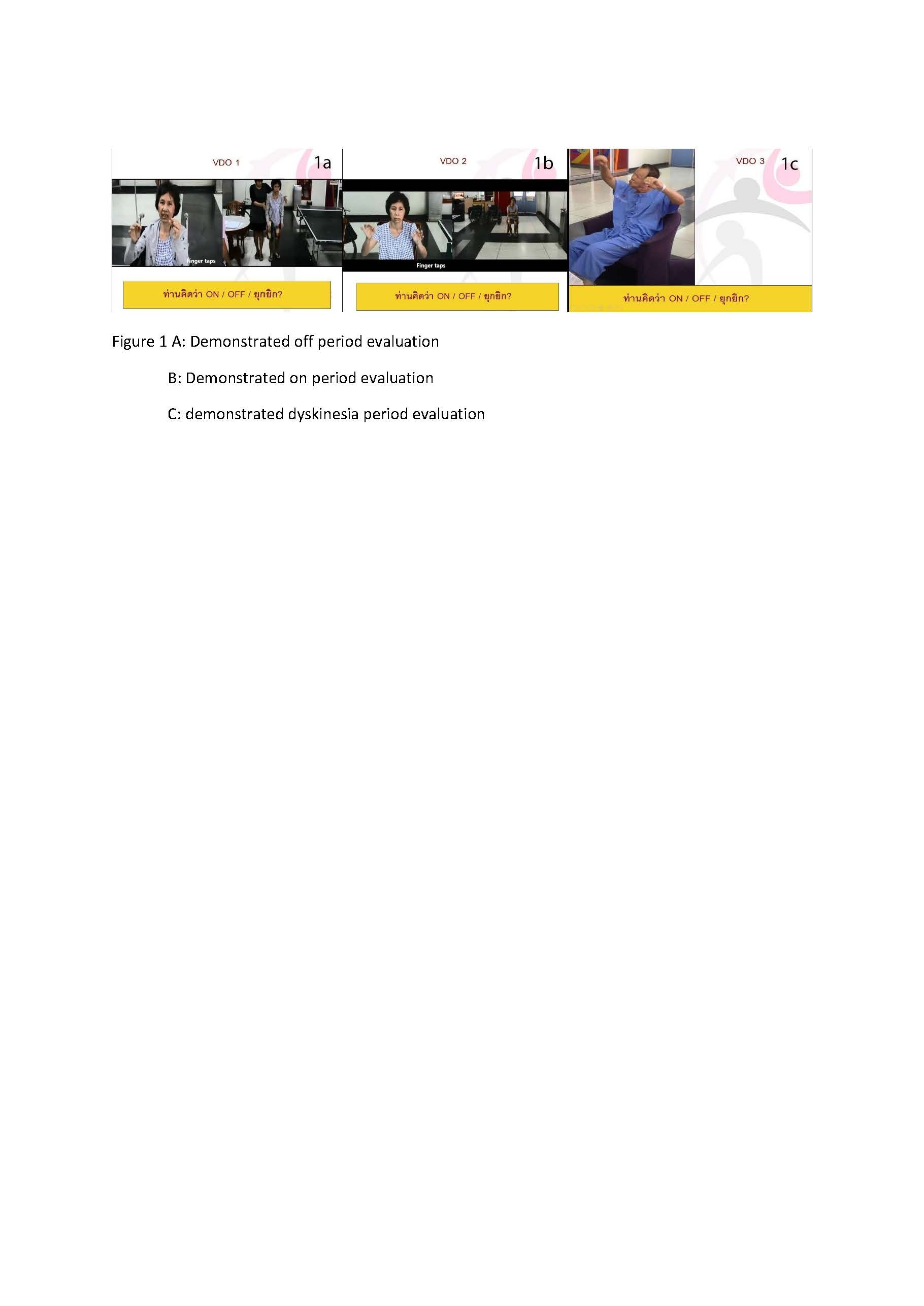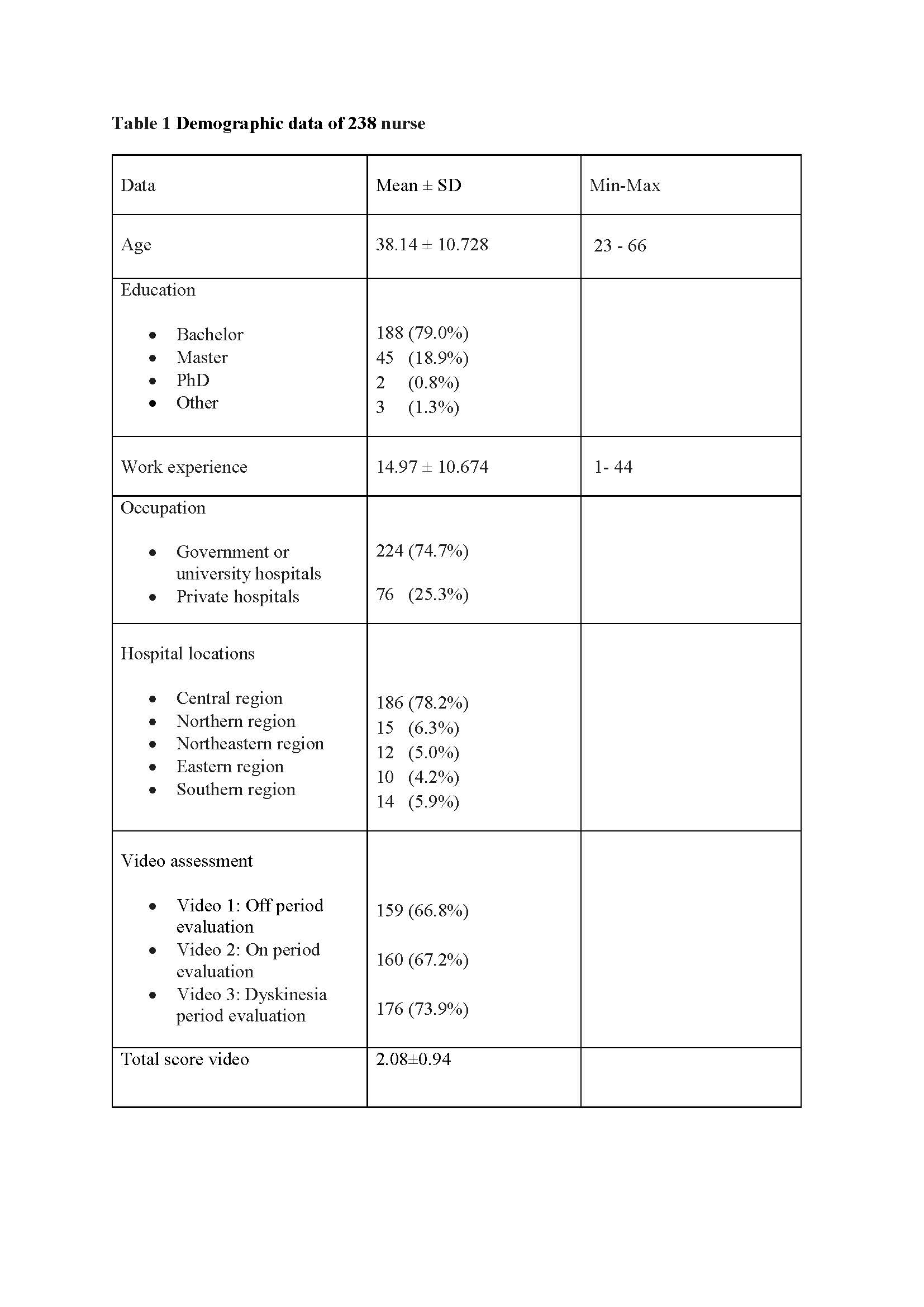Session Information
Date: Sunday, October 7, 2018
Session Title: Phenomenology and Clinical Assessment Of Movement Disorders
Session Time: 1:45pm-3:15pm
Location: Hall 3FG
Objective: To evaluate awareness of the three main parkinsonian motor symptomatologies, among general nursing population.
Background: One aim of Parkinson’s disease (PD) management is to decrease daily motor fluctuations and the time spent in the ‘off’ state or in the ‘on’ state with disabling dyskinesia. Information about the frequency of such fluctuations is usually obtained from on/off diaries kept by patients under the supervision of experienced nurses. Skilled analysis allows the early detection and identification of various motor conditions throughout the day, which can help physicians in appropriate medication adjustments and improve patient outcomes.
Methods: A cross-sectional survey, using a series of video-based materials, was conducted to assess the awareness of 238 Thai registered nurses of the three main motor symptomatologies, including ‘off’ state, ‘on’ state, and ‘on’ with disabling dyskinesia. Three video-based questions, developed by movement disorders experts with content verification by general neurologists, were used with a maximum score of 3 points. A higher score indicate a higher level of parkinsonian symptom recognition. Demographic data and scoring from all participants was included in the analysis.
Results: All participants were registered nurses in Thailand with a mean age of 38.14 years (10.73), and a mean working experience of 14.97 (10.67) years. A lack of specialist knowledge amongst this population is reflected by the mean total score of 2.08 (0.94). Though, 66.8% of participants gave the correct answers for ‘on with disabling dyskinesia’ identification and 67.2% of participants gave the correct answers for ‘off’ state identification, only 73.9% of participants gave the correct answers for ‘on’ state identification. This lack of understanding hinders their ability to instruct patients to identify parkinsonian symptomatology from on/off diaries and highlights the importance of developing educational program to improve nurses’ knowledge.
Conclusions: The results from this study identifies significant knowledge gaps in recognizing symptoms related to motor fluctuations from on/off diaries. As nurses have an important role in both patient education and communicating and translating patient’s symptoms to clinicians, improving their knowledge is vital to improve disease management. Development of an educational program about PD for nurses will provide better doctor-patient communication and raise the standard of patients’ care.
References: 1. Reimer J, Grabowski M, Lindvall O, Hagell P. Use and interpretation of on/off diaries in Parkinson’s disease. J Neurol Neurosurg Psychiatry 2005;75:396-400. 2. Jitkritsadakul O, Boonrod N, Bhidayasiri R. Knowledge, attitudes and perceptions of Parkinson’s disease: A cross-sectional survey of Asian patients. J Neurol Sci. 2017; 374:69-74.
To cite this abstract in AMA style:
K. Boonpang, O. Jitkritsadakul, P. Plengsri, S. Chaiwong, N. Kantachadvanich, R. Bhidayasiri. How well can nurses recognize motor fluctuations in Parkinson’s disease: A survey of 238 registered nurses [abstract]. Mov Disord. 2018; 33 (suppl 2). https://www.mdsabstracts.org/abstract/how-well-can-nurses-recognize-motor-fluctuations-in-parkinsons-disease-a-survey-of-238-registered-nurses/. Accessed March 6, 2025.« Back to 2018 International Congress
MDS Abstracts - https://www.mdsabstracts.org/abstract/how-well-can-nurses-recognize-motor-fluctuations-in-parkinsons-disease-a-survey-of-238-registered-nurses/


